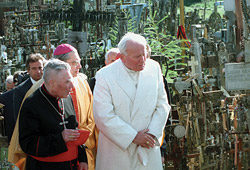As the 15th anniversary of Pope John Paul II’s apostolic visit to Lithuania approached, ways were sought to mark the occasion and reflect on the memory of this Servant of God. The bishops of Lithuania proposed joining together the main shrines in Lithuania and that are connected with this Pope to form a Pilgrim Route of John Paul II. The Lithuanian government approved the plan for such a route on August 8, 2007. It currently includes 16 prominent pilgrimage sites.
During his visit in 1993, Pope John Paul II gave valuable guidance for the life of the Catholic Church in Lithuania and for the nation as a whole. In homilies and speeches, the Holy Father presented the sources of spiritual regeneration and the principles on which a free life must be built to this people that had only just delivered itself from the yoke of totalitarianism. The Pilgrim Route of John Paul II aims to remind people of the universally valid foundations for a true and complete life which the pope so emphasized: Christ, the Cross, the Holy Spirit, and Mary’s example of faith and virtue. In light of this purpose, the route includes not only the sanctuaries which the pope visited in Lithuania, but also other sites of pious renown which received the Holy Father’s attention.
In Vilnius, pilgrims following in the footsteps of John Paul II may see Vilnius Cathedral and its chapel with the tomb of St Casimir, Patron of Lithuania. They can also pray at the Gate of Dawn before the world famous image of Mary the Mother of Mercy. The theme of the Cross, so emphasized by the Pope in Lithuania, is reflected brilliantly in the Way of the Cross at Vilnius Calvary.
In Trakai pilgrims will discover a painting of the Mother of God and Child which has a long tradition of pious renown, and which is closely associated with the efforts of Lithuanian Grand Duke Vytautas to bring Lithuania into the family of Christian nations.
Pivašiūnai also presents pilgrims with a painting, renowned for graces and adorned with crowns blessed by Pope John Paul II, of Mary the Comfort of the Afflicted.
And in the basilica of Marijampolė one can kneel to pray by the remains of Archbishop Jurgis Matulaitis, whom John Paul II beatified.
Christ’s Resurrection Church, rising high into the Kaunas city skyline, reflects the path travelled by the Lithuanian people in the 20th century and seems to recall the prayer of John Paul II for the nation’s spiritual rebirth. At Kaunas Cathedral, where the pope came to pray privately, a painting of Our Lady of Sorrows – long associated with many special graces – generally captivates pilgrims.
The Pažaislis monastery, which is enjoying a spiritual renaissance under the care of the Sisters of St Casimir, is sure to fascinate visitors with its inimitable architecture and art. A painting here of Mary the Mother of Fair Love, the object of ages-old pious traditions, continues moving visitors to prayer.
The renovated shrine complex of Šiluva spreads the Christological message left by the Blessed Virgin Mary during an apparition in the town in 1608: “My Son used to be worshipped in this place…” Pilgrims can pray in the Apparition Chapel as well as in the nearby Basilica, before a painting of Mary, Health of the Sick, which has long been considered miraculous.
The Tytuvėnai monastery and church complex is notable for its Stations of the Cross, as well as for the Holy Steps Chapel modelled on a chapel at the Lateran Palace in Rome.
Šiauliai Cathedral is a frequent starting point for pilgrimages by foot to the Hill of Crosses, which in turn was made world-famous by Pope John Paul II, who spoke here about the mystery of the Cross.
For its part, Samogitian Calvary maintains authentic centuries-old Way of the Cross traditions. The shrine also attracts pilgrims for its celebrated painting of Mary the Queen of the Christian Family and for the annual Great Indulgenced Feast of Samogitian Calvary.
And Krekenava has long been known for a miraculous image of the Mother of God and for the Indulgenced Feast of the Assumption. Krekenava Church is Lithuanian's only daughter shrine of the Roman Basilica of St. Mary Major.








